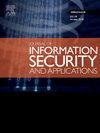Real-time Automotive Ethernet Intrusion Detection Using Sliding Window-Based Temporal Convolutional Residual Attention Networks
IF 3.7
2区 计算机科学
Q2 COMPUTER SCIENCE, INFORMATION SYSTEMS
Journal of Information Security and Applications
Pub Date : 2025-10-13
DOI:10.1016/j.jisa.2025.104263
引用次数: 0
Abstract
As vehicles become more intelligent and connected, automotive Ethernet is gradually replacing the traditional CAN bus as the backbone of in-vehicle networks. However, this transition introduces new security vulnerabilities. This paper presents a novel centralized network architecture and explores potential intrusion threats. Existing intrusion detection methods struggle to handle automotive Ethernet protocols universally and typically use a single machine learning network structure. Additionally, these models often fail to ensure temporal sensitivity and real-time performance. To address these issues, we propose Sliding Window-Based Temporal Convolutional Residual Attention Networks (SW-TempCRAN), a real-time intrusion detection system tailored for automotive Ethernet environments. SW-TempCRAN integrates several novel components, including protocol-general windowed feature extraction, time-aware positional encoding, convolutional residual attention networks and MLP classification with sequence-feature aggregation. It uses custom protocol-parsing scripts to extract key header and merge payload data, and combines Convolutional Neural Networks (CNN) with attention residual mechanisms. This design allows the model to capture attack patterns over time, identify local features and compress the computational load. We also improve positional encoding to better suit network traffic data, ensuring time sensitivity, while pre-generating the encoding matrix to avoid real-time computation complexity. Experiments on two public datasets show SW-TempCRAN outperforms state-of-the-art methods in evaluation metrics. SW-TempCRAN achieves F1-scores of 99.82 % and 98.05 % on two datasets, with a detection delay of less than 1.5 ms on a server testbed.
基于滑动窗口的时间卷积剩余注意网络的实时汽车以太网入侵检测
随着汽车智能化和互联化程度的提高,汽车以太网正逐渐取代传统的CAN总线,成为车载网络的骨干。然而,这种转换引入了新的安全漏洞。本文提出了一种新的集中式网络架构,并探讨了潜在的入侵威胁。现有的入侵检测方法难以处理通用的汽车以太网协议,并且通常使用单一的机器学习网络结构。此外,这些模型往往不能保证时间敏感性和实时性。为了解决这些问题,我们提出了基于滑动窗口的时间卷积剩余注意力网络(SW-TempCRAN),这是一种针对汽车以太网环境量身定制的实时入侵检测系统。SW-TempCRAN集成了几个新组件,包括协议通用窗口特征提取,时间感知位置编码,卷积剩余注意网络和序列特征聚合的MLP分类。它使用自定义协议解析脚本来提取关键头和合并有效负载数据,并将卷积神经网络(CNN)与注意力残留机制相结合。这种设计允许模型随时间捕获攻击模式,识别局部特征并压缩计算负载。我们还改进了位置编码以更好地适应网络流量数据,保证了时间敏感性,同时预生成编码矩阵以避免实时计算的复杂性。在两个公共数据集上的实验表明,SW-TempCRAN在评估指标方面优于最先进的方法。SW-TempCRAN在两个数据集上的f1得分分别为99.82%和98.05%,在服务器测试台上的检测延迟小于1.5 ms。
本文章由计算机程序翻译,如有差异,请以英文原文为准。
求助全文
约1分钟内获得全文
求助全文
来源期刊

Journal of Information Security and Applications
Computer Science-Computer Networks and Communications
CiteScore
10.90
自引率
5.40%
发文量
206
审稿时长
56 days
期刊介绍:
Journal of Information Security and Applications (JISA) focuses on the original research and practice-driven applications with relevance to information security and applications. JISA provides a common linkage between a vibrant scientific and research community and industry professionals by offering a clear view on modern problems and challenges in information security, as well as identifying promising scientific and "best-practice" solutions. JISA issues offer a balance between original research work and innovative industrial approaches by internationally renowned information security experts and researchers.
 求助内容:
求助内容: 应助结果提醒方式:
应助结果提醒方式:


